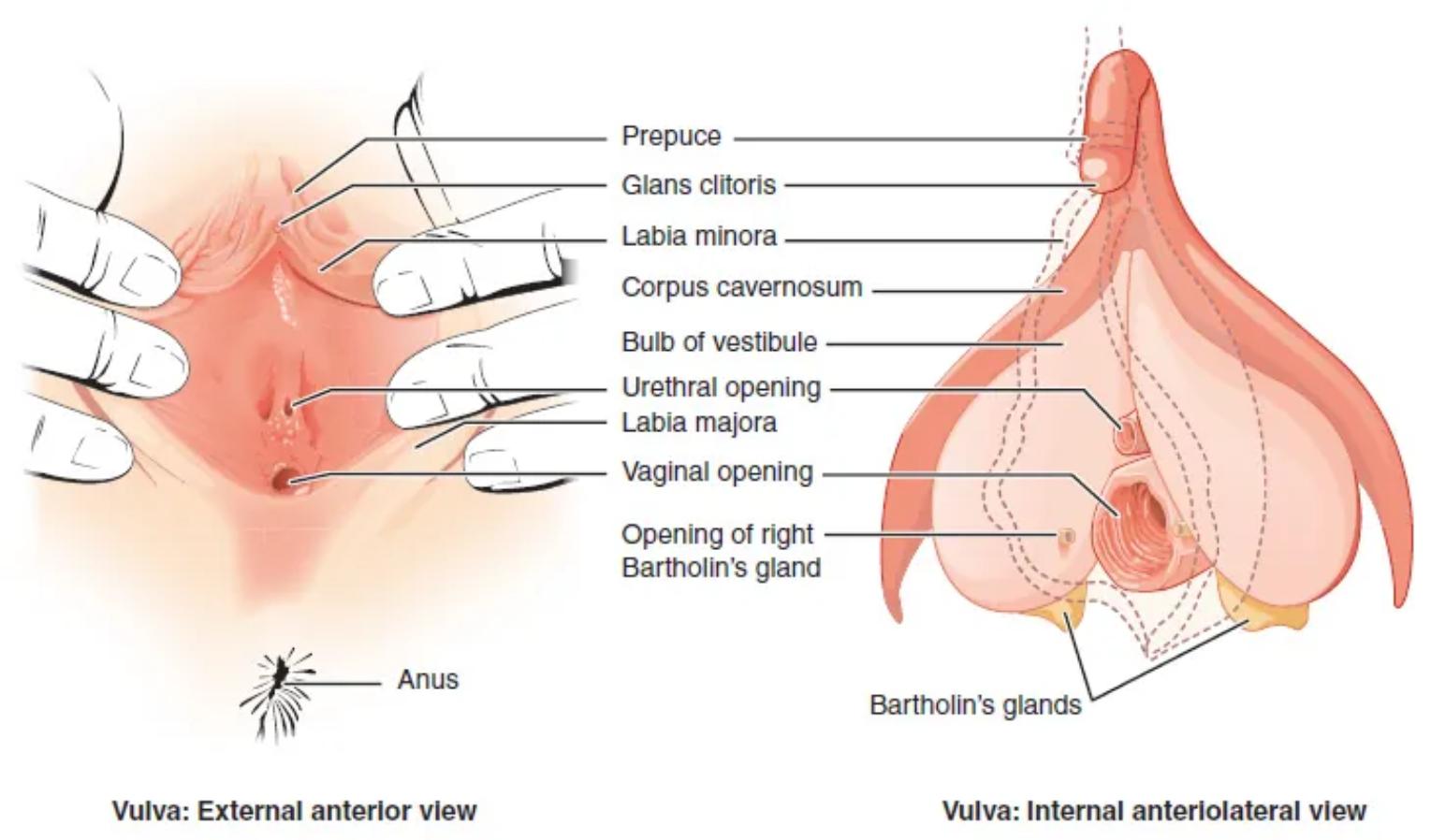The vulva, comprising the external female genitalia, is a complex and vital region with crucial roles in protection, sexual sensation, and reproduction. This article provides an in-depth look at its anatomy, explaining each component from both external and internal perspectives. Gaining a comprehensive understanding of the vulva’s structures is essential for appreciating female health and sexual well-being.

Prepuce: The prepuce, also known as the clitoral hood, is a fold of skin that covers and protects the clitoris. It is homologous to the foreskin in males and plays a role in clitoral stimulation.
Glans clitoris: The glans clitoris is the highly sensitive, visible tip of the clitoris, located at the anterior junction of the labia minora. It is richly innervated and is the primary center for female sexual pleasure.
Labia minora: The labia minora are two delicate, hairless folds of skin located medial to the labia majora. They enclose the vestibule and help protect the clitoris, urethral opening, and vaginal opening.
Corpus cavernosum: The corpus cavernosum refers to the erectile tissue within the body of the clitoris, extending internally from the glans. This tissue engorges with blood during sexual arousal, contributing to clitoral erection.
Bulb of vestibule: The bulb of vestibule consists of two elongated masses of erectile tissue located on either side of the vaginal opening, deep to the labia minora. These structures engorge with blood during arousal, narrowing the vaginal opening and enhancing pressure on the clitoris.
Urethral opening: The urethral opening is the external orifice of the urethra, through which urine exits the body from the bladder. It is located posterior to the clitoris and anterior to the vaginal opening.
Vaginal opening: The vaginal opening, also known as the introitus, is the external entrance to the vagina. It serves as the pathway for menstrual flow, sexual intercourse, and childbirth.
Labia majora: The labia majora are two large, fleshy folds of skin that form the outermost boundaries of the vulva. They are typically covered with pubic hair after puberty and provide protection to the underlying delicate structures.
Opening of Bartholin’s gland: The opening of Bartholin’s gland is a small duct located on either side of the vaginal opening, typically at the posterior aspect of the labia minora. These glands secrete mucus to lubricate the vestibule, especially during sexual arousal.
Bartholin’s glands: Bartholin’s glands are a pair of pea-sized glands located slightly posterior and to the left and right of the opening of the vagina. They secrete fluid to lubricate the vagina and vulva during sexual activity.
Anus: The anus is the external opening at the end of the gastrointestinal tract, through which feces are expelled. While not part of the reproductive system, its close anatomical proximity to the vulva is relevant for clinical considerations and hygiene.
The Multifaceted Vulva: An Introduction
The vulva represents the external female genitalia, a region of significant anatomical and physiological importance. Far more than just an external facade, it encompasses a range of structures that are critical for protection, sexual response, and reproductive health. Understanding the intricate details of the vulva’s anatomy is fundamental for healthcare professionals and individuals alike, fostering a deeper appreciation for the female body.
The diagrams provided offer a clear visualization, presenting both an external anterior view and an internal anteriolateral perspective. This dual approach allows for a comprehensive understanding of how superficial structures relate to deeper, often less visible, components. From the sensitive clitoris to the protective labia and the lubricating glands, each part plays a vital role in the overall function and well-being of the female reproductive system.
Key aspects of the vulva’s anatomy include:
- The protective role of the labia majora and minora.
- The central role of the clitoris in sexual sensation.
- The openings for both urinary and reproductive functions.
- The presence of glands for lubrication.
This intricate design underscores the vulva’s importance in both sexual function and facilitating reproduction, making its detailed study essential for a holistic view of female anatomy.
Anatomical and Functional Significance
The external female genitalia, collectively known as the vulva, are strategically positioned to protect the internal reproductive organs and provide sensory input. The labia majora, being the outermost folds, offer a primary layer of protection for the more delicate structures beneath. Medial to these are the labia minora, which are hairless folds that further shield the urethral and vaginal openings, as well as the clitoris. The clitoris itself is a remarkable organ, homologous to the male penis, composed of erectile tissue, including the glans clitoris and internal corpora cavernosa. Its rich nerve supply makes it highly sensitive to touch, playing a paramount role in female sexual arousal and orgasm.
Beneath the surface, within the vestibule (the space enclosed by the labia minora), lie important structures such as the urethral opening, through which urine passes, and the larger vaginal opening, which serves as the entry point to the vagina. Also crucial are the Bartholin’s glands, located near the vaginal opening. These glands are responsible for secreting mucus, especially during sexual arousal, which lubricates the vestibule and facilitates intercourse. A condition known as a Bartholin’s cyst or abscess can occur when the duct of one of these glands becomes blocked, leading to a painful swelling. Understanding the precise location and function of each of these vulvar components is critical for accurate diagnosis, treatment, and overall female health management.
In conclusion, the vulva is a highly specialized and essential region of the female anatomy, integral to both protective functions and sexual health. Its intricate arrangement of external folds, erectile tissues, and lubricating glands ensures both physical safeguarding and physiological responsiveness. A thorough grasp of its detailed anatomy is fundamental for healthcare providers and for enhancing general knowledge regarding female reproductive and sexual well-being.

